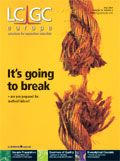New Technologies
Any wine can suffer from that corked wine taint. This spoilage, recognized by a distinct aroma of damp musty leaves and a damp cardboard taste, makes a wine undrinkable.
Any wine can suffer from that corked wine taint. This spoilage, recognized by a distinct aroma of damp musty leaves and a damp cardboard taste, makes a wine undrinkable.

It has been estimated to affect between 2–5% of wines and has long been attributed to the interaction of the natural cork stopper with the wine, so producing a number of chlorinated anisoles; the main compound being 2,4,6-trichloroanisole (TCA).
The level at which these chlorinated anisoles taint wine is as low as 1 ng/L. If you have 12 bottles of wine, then there is more than a 50% chance that one of the bottles will have a taint of TCA or one of its related compounds. There is also a probability that all the bottles will have trace levels of TCA at or below the 5 ng/L level.
As a solution Platinium Wine has developed a wine recovery cartridge that removes this corked wine taint. The Platinium cartridge is a disposable solid-phase extraction (SPE) cartridge that extracts the TCA from the wine by bonding it onto a silica matrix containing a TCA-specific ligand. So, when a tainted wine passes over the cartridge the TCA is held by the ligand and so removed from the wine.

To ensure that the Platinium Wine cartridge captures all the chloroanisoles the support material that holds the ligand has a surface area of over 200 m2/gm. The Platinium Wine cartridge can clean up a bottle of tainted wine in 10 min.
Operation of the cartridge has been made as simple as possible. The cartridge is designed to fit inside a holder inside a handblown glass decanter.
The bottle of corked wine is then poured into the reservoir holding the cartridge and it filters through the cartridge into the decanter. This takes 5–10 minutes for a 125 mL bottle of wine. When the wine has filtered through the cartridge the holder can be removed and the wine dispensed from the decanter.
Full details can be found on the Platinium Wine website at www.pt-wine.co.uk
Analytical Challenges in Measuring Migration from Food Contact Materials
November 2nd 2015Food contact materials contain low molecular weight additives and processing aids which can migrate into foods leading to trace levels of contamination. Food safety is ensured through regulations, comprising compositional controls and migration limits, which present a significant analytical challenge to the food industry to ensure compliance and demonstrate due diligence. Of the various analytical approaches, LC-MS/MS has proved to be an essential tool in monitoring migration of target compounds into foods, and more sophisticated approaches such as LC-high resolution MS (Orbitrap) are being increasingly used for untargeted analysis to monitor non-intentionally added substances. This podcast will provide an overview to this area, illustrated with various applications showing current approaches being employed.








